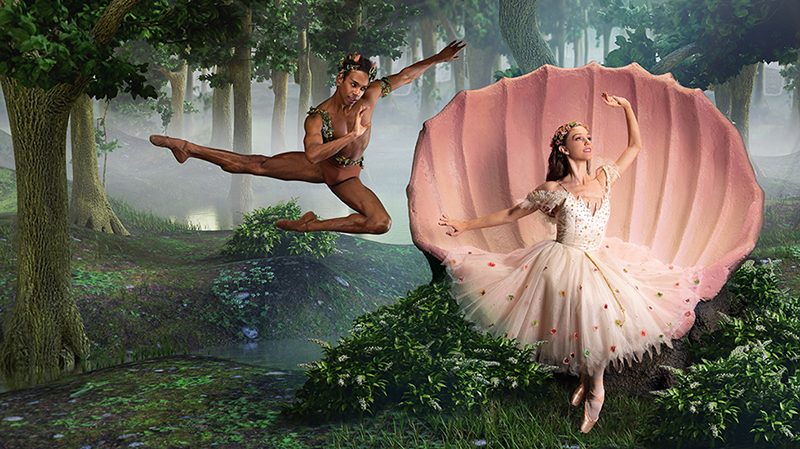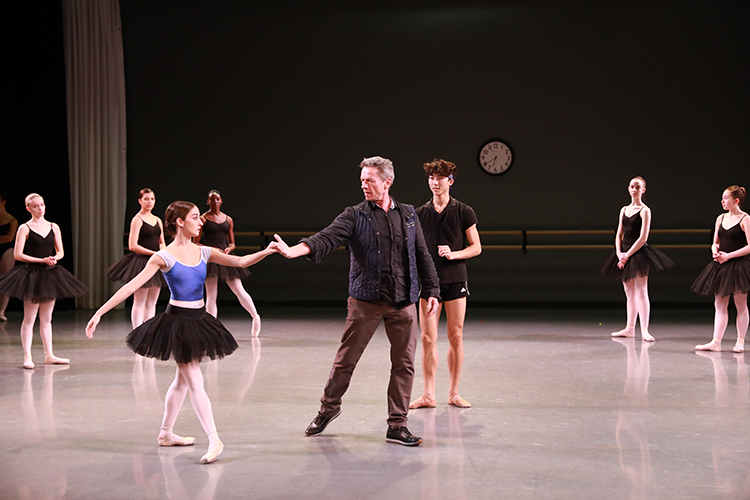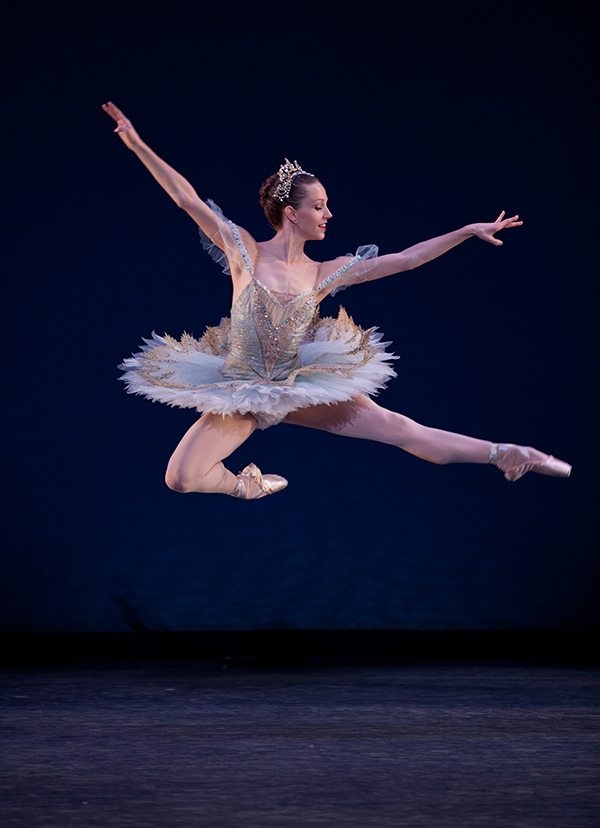Writer Shannon Severson
Photography Courtesy of Ballet Arizona and Alexander Iziliaev
[dropcap]T[/dropcap]wenty years ago, the future of Ballet Arizona—and ballet in Arizona—hung in the balance.
The cultural landscape in Phoenix was in its infancy and struggling to gain a foothold. Within a week of being hired as artistic director by then-Board Chair Gwen Hillis, Ib Andersen was told the entire endeavor would shut its doors if they did not quickly raise $450,000.
“It was a dramatic start,” Andersen recalls. “We raised the money. The first couple of years were scary. We didn’t know if we would make payroll each week. Sometimes we had to borrow money from board members to pay the dancers. It’s different now, but being in the arts, financing is always a challenge.”
Ballet Arizona is in the midst of its 34th season and is about to bring the Shakespearean comedy “A Midsummer Night’s Dream” to the stage Feb. 13–16 with the live accompaniment of the Phoenix Symphony.
It is a fantastical tale with a lovable cast of quarreling fairies, mistaken identities and plenty of laughter. It is also an exceptionally beautiful production with new costumes, sets and choreography—all orchestrated by Andersen, who makes decisions as minute as what threads New York costume designer Fabio Toblini will use in each costume.
“It’s very collaborative and it’s going to be super exciting,” he says. “We started from scratch, one costume and one set at a time. Our sets are being built here under the direction of lighting and set designer Michael Korsch, who I’ve worked with for 19 years. He’s phenomenal.”
Feast for the Eyes, Heart and Imagination
Andersen likens planning each season to cooking a meal from ingredients you already have in your pantry and refrigerator, and on a limited budget.
“You have to think of the meal you haven’t cooked,” he explains. “The thing you haven’t seen, using only what you already have, to present something new. And you might have only carrots and peas!”
Year after year, audiences are delighted by Andersen’s feast for the eyes, heart and imagination. His vision, innate talent and years of dedication have anchored Ballet Arizona as the only professional ballet company in the state and brought international acclaim for his visually resplendent and technically superior productions.
All the attention tends to make this natural born introvert a bit uncomfortable. He doesn’t crave the accolades. His reward is seeing his work performed on stage and having the chance to evolve and create every day.
As he reflects back upon years that in some ways have flown by, he notes how the organization and the area have changed and grown.
“Arizona is completely different from when I first arrived,” he notes. “We are a big city now and I think I’ve experienced that expansion and contributed to bringing more of a variety of culture; something for people to experience apart from the nature and good weather.”
One of the game changers Andersen credits for the growth of the school and performing arts company is its move to a 50,000-square-foot headquarters in 2013. With seven state-of-the-art studios, a performance space, offices, costume and scene shops, it has enhanced his ability to attract and train talent from all over the world. The company now employs 30 professional dancers.
“Over 20 years, we have created a repertoire that wasn’t here before,” he explains. “To do the classics, you usually need 50–75 dancers. I had to choreograph in order to bring in those audiences. Without that, we wouldn’t have been able to survive. It’s out of necessity, you could say.”
He’s established some much-anticipated annual traditions at Ballet Arizona, including “All Balanchine,” the dazzling $1.8 million production of “The Nutcracker” and “An Evening at Desert Botanical Garden,” where dancers perform at sunset with the desert as a stunning natural backdrop.
“I’m proud of what we’re doing at the botanical garden and the money we raised for the new ‘Nutcracker’ production,” he says. “‘Romeo and Juliet’ also stands out to me. I’m proudest of having lasted this long without slacking. I actually feel I’m better now than I was 20 years ago.”
A Balanchine Repetiteur
Throughout his professional career as a dancer, ballet master, choreographer and artistic director, Andersen has excelled.
He began dancing lessons at age 3. By age 7, he was dancing, acting and singing professionally with the Royal Danish Ballet School.
At the time, the school employed 1,000 people and performed operas, plays and ballets. Andersen recalls catching the bus on his own for the early morning 45-minute trip to the school, where he would train six days per week with performances each night that ended at 11:30 p.m.
Looking back, it was just a different era that allowed him to live life and pursue his passions so independently; he did not know any other life than the one he lived as a young performer and he loved what he was doing.
By age 16, Andersen had joined the Royal Danish Ballet. At age 20, he became the youngest principal in the company’s history and was performing all over Europe. A performance in New York City drew the attention of the New York City Ballet and its legendary co-founder and artistic director, George Balanchine—who is widely regarded as the father of American Ballet.
“Balanchine was sick that day, but I was invited to a future audition with him in London,” Andersen recalls. “He saw me for five minutes and invited me right away. I couldn’t just walk away from Royal Danish Ballet, so seven months later I moved to New York and danced for 10 years.”
Balanchine was so impressed by Andersen that he created principal roles especially for him. Today, Andersen is one of a handful of choreographers worldwide appointed as a Balanchine Repetiteur, meaning he has been granted authorization by The George Balanchine Trust to stage the legend’s pieces, much to the delight of Arizona audiences.
Because of his talent and notoriety, Andersen was invited back to Copenhagen as a guest choreographer for the Royal Danish Ballet while he was still with New York City Ballet.
“I started choreographing and once you start, you get the bug,” he says. “You start thinking maybe the next will be even better. I’ve always had an eye for technique and an interest in helping people do better. As a choreographer, you’re basically a teacher. And with that comes the mental side of getting into another dancer’s psyche. Each person is different and responds to certain methods.
“It can be complicated, but it’s also a gift. You need to have some sort of innate psychology or feeling. I think you have it or you don’t. You can’t learn it. And you have to get along well with people.”
Honoring and Continuing
the Legacy
Ballet Arizona is planning to honor the impact and contributions of Andersen and Hillis at its annual Dance with Me Gala at The Camelback Inn on April 18.
“We are so proud to be celebrating these two extraordinary individuals this year,” says Samantha Turner, executive director of Ballet Arizona. “It is safe to say that the company might not exist today without the work of these two passionate people.
“Gwen Hillis rallied the community in support of the ballet 20 years ago when it faced financial crisis. And Ib has created an artistic jewel in the desert that has elevated the arts and cultural offerings in our community for many years.”
As he heads into the next 20 years, Andersen is always dreaming of the next thing, the next challenge. One of those dreams is working with a composer on a commissioned score.
“I’ve tried most things, I think, but I haven’t tried that,” he says. “I have a few composers in mind. The ones I have interest in might take five years to complete it, but it would be fun to do.”
Retirement is not even a passing thought.
“I don’t really believe in retiring unless you really have something to do and you need to do something you love,” he says. “It’s not enough to just have time. You have to have something you use your time for.
“In that way, I want to die working. Maybe not working as hard as I do now, but I don’t believe in retiring. You need to keep physically fit and your brain active and you need to challenge yourself and hopefully you need to do something you haven’t done before.”
Ballet Arizona’s A Midsummer Night’s Dream
Feb. 13–16 | 11 a.m.–7 p.m. | Symphony Hall | 2835 E. Washington Street, Phoenix | $25+ | 602-381-1096 | balletaz.org









Comments by Admin